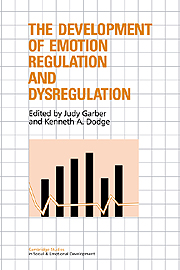Book contents
- Frontmatter
- Contents
- List of contributors
- Preface
- Part I Introduction
- Part II Early development
- 2 Contributions from the study of high-risk populations to understanding the development of emotion regulation
- 3 Development of emotion expression during infancy: General course and patterns of individual difference
- 4 Infant social referencing
- 5 Relationships, talk about feelings, and the development of affect regulation in early childhood
- Part III Physiological regulation
- Part IV Cognitive regulation
- Part V Psychopathology
- Part VI Integration
- Author index
- Subject index
4 - Infant social referencing
Published online by Cambridge University Press: 26 March 2010
- Frontmatter
- Contents
- List of contributors
- Preface
- Part I Introduction
- Part II Early development
- 2 Contributions from the study of high-risk populations to understanding the development of emotion regulation
- 3 Development of emotion expression during infancy: General course and patterns of individual difference
- 4 Infant social referencing
- 5 Relationships, talk about feelings, and the development of affect regulation in early childhood
- Part III Physiological regulation
- Part IV Cognitive regulation
- Part V Psychopathology
- Part VI Integration
- Author index
- Subject index
Summary
The experience and regulation of emotion have usually been viewed as intrapersonal events, that is, events controlling the experience of emotion have been seen as originating and operating primarily within the individual. Social psychologists, with their focus on social influences on behavior, have contributed greatly to our understanding of interpersonal aspects of emotion (Arnold, 1970; Lazarus & Averill, 1972; Schachter, 1959), and developmental psychologists, as well, have considered interpersonal factors in emotion regulation, perhaps because the effects of interpersonal events on emotional regulation can be more observable in very young children. Much of the early work on social influences on infants' affect and its consequences was seen as indicating the importance of the social environment that impinges on the passive or, at best, responsive infant. Not until the mid-1960s did scientists regularly describe an active infant who sought and used input from objects and others as an organizational tool.
This chapter will discuss data that support the position that processes of emotional regulation include the child's use of other persons in affect-inducing situations. Thus, we shall consider affect regulation in the interpersonal context in which it occurs. One way in which young children use interpersonal information to regulate affect is by referring to others' reactions to events. They may then use this information about others' responses to guide their own responses. This chapter will also describe the phenomenon of social referencing and some early developmental changes in the referencing of others' affective expressions in situations of uncertainty.
- Type
- Chapter
- Information
- The Development of Emotion Regulation and Dysregulation , pp. 69 - 88Publisher: Cambridge University PressPrint publication year: 1991
- 28
- Cited by



